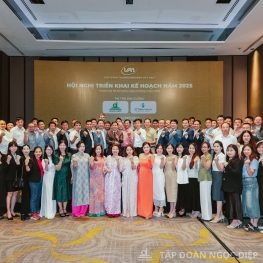Important considerations when choosing export carton packaging
In Vietnam, carton packaging has become an indispensable item for the export process of businesses. Carton packaging is cost-effective, lightweight, yet still ensures the safe preservation of goods during transportation. In today’s article, Ngoc Diep Packaging will introduce you to the set of standards for export carton packaging, let’s find out now!

1. ADVANTAGES OF CARTON PACKAGING IN EXPORT GOODS PACKAGING
Exported goods often have to undergo a long transportation period over long distances, which can last for several months if shipped by sea. Therefore, preserving the quality of goods is always a challenging task for export businesses.
The emergence of premium carton packaging has become a lifesaver for Vietnamese businesses, as they have characteristics that are very suitable for preserving exported goods, such as:
– Paper with high durability, good compressive strength, helping to protect products from impacts, damages during transportation.
– Good moisture resistance and waterproofing ability, which can limit some harmful factors from the environment such as dust, insects…
– Usually, they come in 3, 5, or 7 layers depending on the goods they need to preserve, the thicker the layers, the higher the durability.
In addition to the above common characteristics, for each different type of product or export to different markets, there will be additional specific standards prescribed by the importing country. Vietnamese enterprises need to be aware of these standards to ensure that their goods are approved for entry.
2. STANDARDS FOR DESIGNING EXPORT CARTON PACKAGING BY INDUSTRY
2.1 Standards for export carton packaging for agricultural products, fruits
Most agricultural products and fruits exported are fresh food items that are susceptible to damage if not properly preserved. Therefore, the packaging process for exported agricultural products needs to focus on the following factors:
Firstly, export carton packaging for agricultural products needs to have high rigidity to withstand pressure when stacked or subjected to impacts during transportation. This is crucial to protect agricultural products from being crushed or deformed.
Secondly, the size of the carton boxes should be designed to fit the size and weight of the agricultural products. This helps to avoid situations where the boxes are either too tight or too loose, thereby optimizing space in the container.
Finally, priority should be given to choosing carton boxes with good paper quality, and the more layers of paper, the higher the waterproof and moisture resistance of the boxes. This helps to prevent agricultural products and fruits from rotting or being damaged due to exposure to high humidity in the air.

2.2 Standards for export carton packaging for wood products, woven bamboo products
According to many experts, the top two crucial factors to consider when choosing export carton packaging for wood products and woven bamboo products are moisture resistance and printing on the box surface.
Wood or handicraft products made from woven bamboo are prone to mold, discoloration if exposed to water for a long time. Therefore, the carton packaging for these products needs to have good moisture resistance to ensure that the products maintain their quality during long-distance transportation, through regions with harsh weather conditions.
In addition, printing colors, images, or text on the carton boxes packaging these items also need to be emphasized because they create a positive impression of the product in the customer’s mind. Furthermore, businesses can also use printing to provide instructions, warnings to be noted during the product transportation process, avoiding damage before reaching the end-user.
2.3 Standards for export carton packaging for textile products
Textile is one of Vietnam’s important export industries and is favored by international markets. Efficient packaging and ensuring quality during export will be a plus point that helps Vietnamese textile products impress international customers more positively.
As textile products belong to the fashion sector, the aesthetic aspect of the carton packaging for textile products is also highly emphasized. The design and printing of the carton box must ensure professionalism and attractiveness.
Similar to the two aforementioned products, carton boxes for textile products also need to have good waterproofing ability, ensuring that the products inside remain dry and intact.

3. STANDARDS FOR DESIGNING EXPORT CARTON PACKAGING ACCORDING TO EACH COUNTRY
3.1 Standards for export carton packaging to the US and EU
When packaging goods for export to other countries such as the US or EU member countries, export carton boxes need to comply with certain quality standards that have been specified. Below are some common standards that you should know:
– RoHS standard: RoHS stands for “Restriction of Hazardous Substances”. This standard strictly prohibits 06 types of substances including Cadmium (Cd), Bromine compounds such as PBBs (polybrominated biphenyls), Mercury (Hg), PBDEs (polybrominated diphenyl ethers), Lead (Pb), and Hexavalent Chromium.
– ASTM D1974 standard: This standard is specified by ASTM International and widely applied by many countries with requirements for the strength of carton boxes after being packed, sealed, and reinforced. These requirements include compressive strength, impact resistance, stackability, and tear resistance of carton boxes during export.
– TAPPI T 816 standard: Used to measure the compressive strength of carton boxes, developed by the Technical Association of the Pulp and Paper Industry (TAPPI). Through this test, it can be determined how much impact and shock the box can withstand.

3.2 Standards for export carton packaging to Japan
Japan is one of the most demanding markets with many strict standards that businesses need to comply with if they want to export goods there. For carton boxes packaging goods, it is necessary to ensure compliance with technical regulations such as JIS Z 0208-1996 and JIS Z 1525-1998. These are two standards issued by the Japanese Industrial Standards (JIS), which regulate testing methods to evaluate the quality of carton boxes. Specifically:
– JIS Z 0208-1996 standard specifies testing methods to evaluate the following characteristics of carton boxes: Thickness, weight, compressive strength, impact resistance, stackability, tear resistance, water resistance.
– JIS Z 1525-1998 standard specifies requirements for the quality of carton boxes, including: Size, material, structure, processing, printing, labeling.
We hope the information provided by Ngoc Diep Packaging above has helped you understand more about the standards for export carton packaging. If you need further advice on carton boxes for your business products, let our experts advise and provide you with the most effective packaging solutions.
————————–
NGOC DIEP PACKAGING
NGOC DIEP JOINT STOCK COMPANY
Headquarters: 35 Hai Ba Trung Street – Hoan Kiem District – Ha Noi city
Tel: 024 3942 1819 – Fax: 024 3942 7981
Factory: Road 206 – Zone B – Pho Noi A Industrial Park – Van Lam – Hung Yen
Website: https://baobingocdiep.vn/
Source: https://baobingocdiep.vn/luu-y-quan-trong-khi-lua-chon-thung-carton-dong-hang-xuat-khau-a309.html










